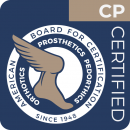Information for Professionals
The following are three case studies of interest for professionals involved in care for the amputee patient, illustrating the complexity involved in good sound prosthetic care. If any attention to detail is overlooked, the patient will never reach their full potential, and that is unacceptable. Although all prosthetic cases are complicated, some are more easily managed due to lower activity levels or healthier bodies in general.
A successful prosthetic case occurs only when the patient feels they are restored in function. This means they have the ability to be fully active in their life, in the most practical, comfortable and secure way. This will be their prosthesis and it should be made by blending their individualized needs with our professional expertise.
If I can ever be of help, please feel free to contact me for a consultation any time.
(All devices shown were created by Kevin S. Garrison, C.P., L.P./Author)
Respectfully,
Kevin S. Garrison, C.P., L.P./Author
Below are three case studies. Click on the link you would like to see.
- Case study involving a traumatic humeral amputation
- Case study involving a complicated proximal femoral focal deficiency
- Case study involving a two finger functional restoration as a result of traumatic finger amputations
Case study involving a traumatic humeral amputation:
This patient, a veteran, expressed a desire to have a strong yet lightweight, practical and functional prosthetic device to assist him as he worked on motorcycles in his garage.
This prosthetic arm (Hybrid Trans-humeral) blends a mechanical body-powered elbow with an external
powered electronic Terminal Device controlled through proportional chest expansion.
 |
 |
| Test socket fitting and alignment with functions testing. The batteries are positioned in the humeral section to lesson the weight of the forearm for ease of control. | Finished arm with graphite finish as veteran requested. Proportional control chest expansion harness is shown; this controls the TD. |
 |
 |
| Proper harnessing is key to functional control as well as cable placement. This prosthesis can be taken on and off independently. | Finished arm in full elbow extension. TD can be opened and closed proportionally in any elbow position and locked if required. |
Case study involving a complicated proximal femoral focal deficiency:
This patient expressed a need for long-term standing to accommodate his current type of employment.
The prosthetic limb was designed to allow easy donning and doffing; self suspension was created through mechanical socket shape and semi-suction via a flexible and adjustable insert liner.
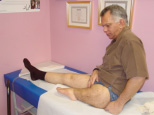 |
 |
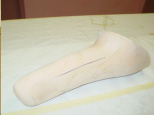 |
| Surgical hip stability. Anterior bowing and lateral to medial twisting of the femur. Ankle is non-functional. | Bi-valve casting technique for irregular shaped limb. Cast cutter is not necessary for cast removal. Maximum accuracy. | Flexible removable insert liner. Offering adjustable peripheral weight-bearing comfort. |
 |
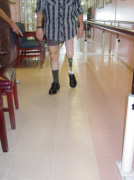 |
 |
| Finished lamination with socket attached to 4-bar pneumatic knee unit. | Ambulation exhibited with excellent balance and control on sound limb. | Ambulation exhibited with excellent balance and control on affected limb. Multiaxial foot. |
Case study involving a two finger functional restoration as a result of traumatic finger amputations:
This patient is a machine worker that expressed the desire to continue working at his same job involving the control of a hydraulic tool and die manufacturing machine.
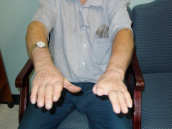 |
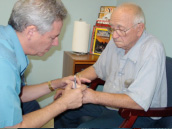 |
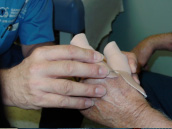 |
| Missing digits at very high levels. | The first of several fitting and alignment sessions. | Rubber extensions are formed and positioned for best grip force possible. |
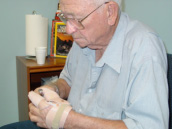 |
 |
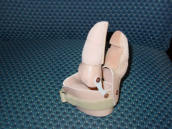 |
| Patient is left alone to test function and offer input as to any corrections necessary. | Finished gripping device constructed with custom laminated finger & palmer sockets. | Lateral view of custom joint and finger pivotal axis points allowing proper function. |


 ADVANCED TECHNOLOGY
ADVANCED TECHNOLOGY
 FREE CONSULTATIONS
FREE CONSULTATIONS